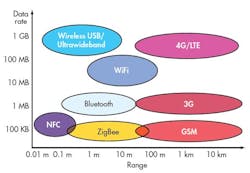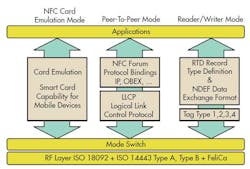This file type includes high resolution graphics and schematics when applicable.
The recent explosion of smartphone users has left many industries scrambling to find ways to best take advantage of the compact computers in everyone’s pocket. With the ability to engage with end users in interactive, consumer-driven media, the smartphone-equipped consumer is a hot topic for the commercial industry. There are very few technologies as well suited to enabling this desired interaction with high-tech consumers as near-field communications (NFC).
Related Articles
• Tablet Sales May Be Declining, But Technology Launches Remain Strong
• NFC-Enabled Cellphones Expected to Dominate by 2018
• Maintaining Security For The Internet Of Things
NFC technology is a very-short-range, fast, low-power, and secure method of communicating between two devices. From within 4 to 8 cm, it is rather well known that a secure communications link can be established between two devices, such as a smartphone and contactless pay-service. But that explanation only scratches the surface of what is possible with this trending technology. Because NFC services can only be activated within close physical proximity of the devices, NFC enables a tangible interaction with a variety of media and consumer infrastructure systems.
The shoe retailer Bonton, for example, embeds NFC tags within its shoes. The NFC-enabled shoe can then be scanned with a curious shopper’s smartphone. An order could be placed with the right shoe size and shipped immediately to the customer’s home. Other retail examples include accessing a video or song through the web when NFC touching a certain product. Even the simple act of scanning a product on an NFC-tagged shelf could give a consumer access to a range of other recommended products at a variety of price points while plugging the latest deals.
These types of uses have led to the inclusion and adoption of NFC standards in an increasing number of environments, which offered little NFC support only a few years ago. According to Matthew Bright, chair of the NFC Forum Retail Special Interest Group and director of technical marketing for Thin Film Electronics: “Historically, the major barrier to market growth had been the adoption rate of the NFC feature in phones. The technology and use cases have been very interesting for a number of years. But it has only been in the last two to three years that we reached an inflection point in terms of NFC penetration into mobile devices. This is due to the fact that a wide variety of stakeholders within the NFC ecosystem have seen value in the technology and encouraged its adoption.”
ABI Research is predicting the number of NFC smartphones shipped worldwide to reach 500 million by the end of 2014. Seeing this growth, more industries are looking to benefit logistically from this technology. Mass-transit systems like buses, trains, and airports may soon be allowing NFC-based boarding passes to help increase the throughput and ease of travelers. Another, more recent NFC application is the fast pairing of devices. With the ability to identify oneself with a personal NFC device like a smart card or smartphone, a user could have access to his or her automobile, home, hotel room, or even secure information through the postal system.
Additionally, two smart devices could use the NFC protocols to establish the optimal method of linking. Higher-data-rate communications could be enabled using other wireless technologies like Bluetooth or WiFi (Fig. 1). This is done in one of NFC’s three modes of operation: peer-to-peer (P2P), reader/writer (R/W), or card emulation mode (Fig. 2). The P2P mode allows communication between two machines using a logical link control protocol (LLCP) for bi-directional communication. As the NFC standards limit communication rates to 424 kb/s, the P2P link will not permit the exchange of large amounts of data. But the link will allow the very fast exchange of small amounts of data, such as payment agreements, URL sharing, and handling the security and coordination of another wireless technology link.
For its part, the reader/writer mode is designed to function between NFC tags installed in a variety of media. A few examples include smart posters with video links, retail products with web-based advertising information, devices that bring up help manuals, mapping functions in recreation facilities, and app store links.
NFC’s card-emulation mode, in contrast, harks back to the operation of RFID-tag systems by merely operating as a secure identifier. This mode is predominantly designed for access control, identification, and payment. Examples for applications include access control for automobiles, rail/public transit-fare redemption, building access, and credit/bank-card replacement. As this information requires sensitive information to be held on the device, highly secure memory-access systems are necessary.
This file type includes high resolution graphics and schematics when applicable.
Securing Memory Access
This file type includes high resolution graphics and schematics when applicable.
The need for secure memory access has piqued the interest of groups behind the SIM and SD card standards to create secure channels between the memory and NFC device (Fig. 3). Additionally, mobile devices that are not NFC enabled can benefit from NFC technology with the integration of an NFC tag in a user-controlled SIM or SD card. The trend of enabling NFC-based payments is predicted to support worldwide transactions totaling $151.7 billion by 2015, according to Frost & Sullivan.
Because NFC technology has only undergone small iterative advancements over time, the focus is not to enhance its technical capability. Rather, the goal is to increase the development of market-driven applications. Bright elaborates: “Now that NFC-capable devices are in the hands of hundreds of millions of users, the goal is working with application developers to build NFC solutions. An example of how the NFC Forum is working with developers is the ‘Spotlight for Developers’ event that the Forum recently hosted in San Francisco. The Spotlight for Developer series of events brings application developers together with leaders from the NFC ecosystem to train developers in the technical implementation and key use cases of NFC technology.”
The adoption of NFC standards has even extended to Android, Blackberry, and Windows Phone 8 building in support at the operating system’s application support interface (API). This level of integration opens up a wide range of applications with wearable technology as well. Among the wearable devices that could be enabled by a simple NFC “touch” interconnect are wireless speakers, headphones, fitness bands, and a variety of medical devices. Because NFC information is secure and can only be accessed in close proximity, sensitive information like medical or military-personnel data could be kept safely at the fingertips of an authorized entity.
New applications and methods of using NFC are controlled by the NFC Forum specifications. A wide range of industry partners actively contribute to the advancement of these specifications. Bright shares: “If you look at the leadership in the NFC Forum, for example, you see well known representatives from market-leading companies and critical industries, including consumer electronics, semiconductors, financial services, and mobile operators. This very broad range of stakeholders understands the power and potential of this technology.”
Related Articles
• Tablet Sales May Be Declining, But Technology Launches Remain Strong
• NFC-Enabled Cellphones Expected to Dominate by 2018
• Maintaining Security For The Internet Of Things
Recently, the NFC Forum announced collaboration with ThinFilm as a principal member. With the cost benefit of having a thin-film-based manufacturing method for NFC tags and device components—with the added benefit of imbedded thin-film memory—the development of NFC systems could be significantly reduced. Additionally, companies like Broadcom and Qualcomm have announced their latest chipsets that integrate NFC in addition to the other wireless technologies that they traditionally support.
With its broad adoption, NFC has increased the depth of interaction between mobile device users and their work, retail, travel, medical, and information-driven lifestyles. Although there haven’t been many breakthroughs with NFC technology from a device perspective, the potential applications of an NFC interactive environment are tremendous. The next few years will witness an ever-increasing NFC-enabled world.
This file type includes high resolution graphics and schematics when applicable.
About the Author
Jean-Jacques DeLisle
Jean-Jacques graduated from the Rochester Institute of Technology, where he completed his Master of Science in Electrical Engineering. In his studies, Jean-Jacques focused on Control Systems Design, Mixed-Signal IC Design, and RF Design. His research focus was in smart-sensor platform design for RF connector applications for the telecommunications industry. During his research, Jean-Jacques developed a passion for the field of RF/microwaves and expanded his knowledge by doing R&D for the telecommunications industry.




